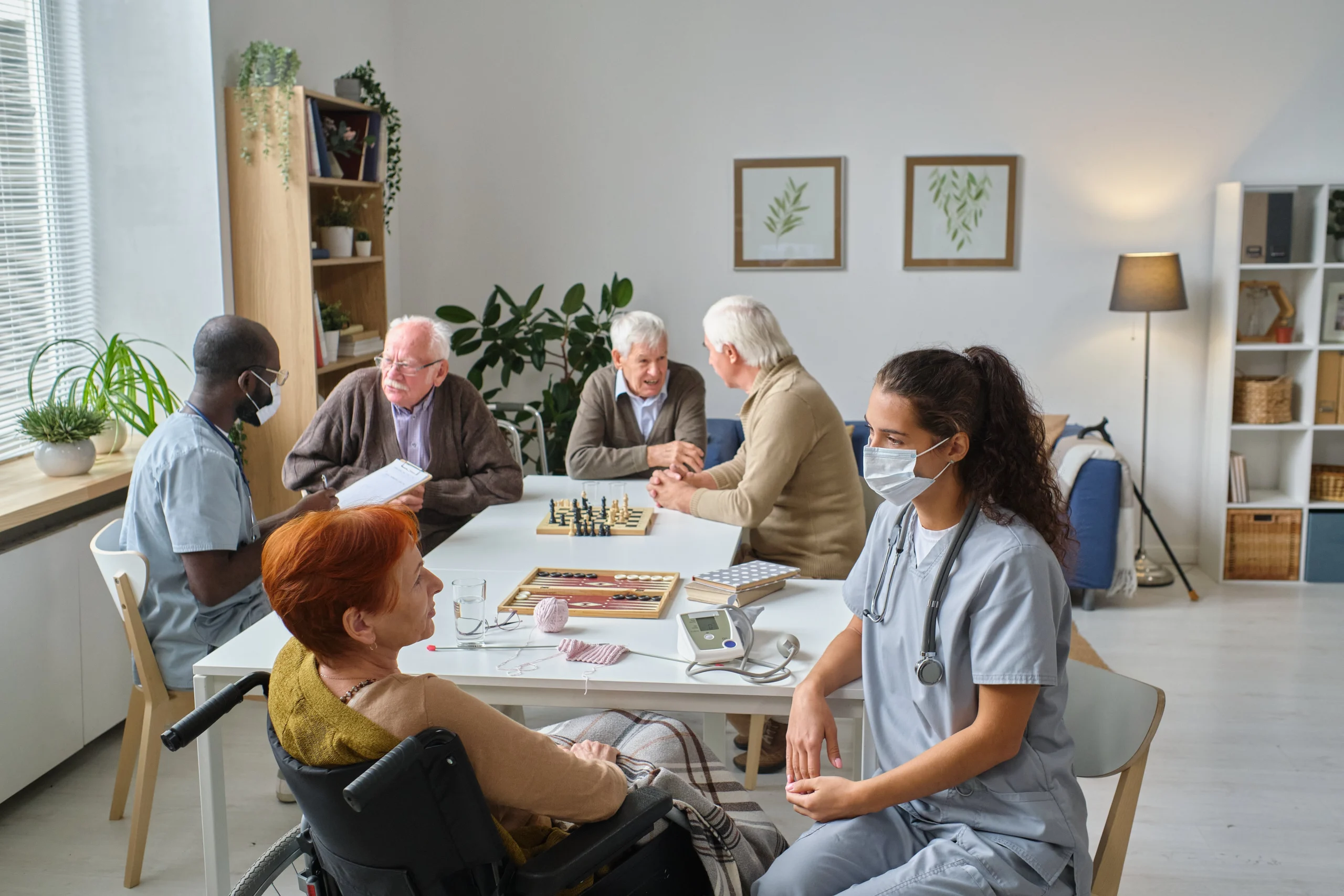Knowing these differences between companion care and medical care helps families make informed decisions that support both health outcomes and quality of life.
What is Companion Care?
Companion care focuses primarily on providing emotional support, friendship, and assistance with daily activities that don’t require medical training.
This type of care addresses the social and practical needs that contribute significantly to an elder’s overall well-being.
A companion care provider typically helps with:
- Engaging conversation and meaningful companionship
- Light housekeeping and meal preparation
- Transportation to appointments or social activities
- Grocery shopping and errand assistance
- Medication reminders (though not medication administration)
- Cognitive stimulation through games, reading, or hobbies
The essence of companion care lies in its human connection. Beyond completing tasks, companion caregivers offer consistent social interaction that combats isolation, a significant health risk for seniors.
Research from the National Institute on Aging suggests that social isolation and loneliness are linked to higher risks of heart disease, depression, cognitive decline, and even premature death.
What is Medical Care?
Medical care, by contrast, involves health services provided by licensed healthcare professionals like registered nurses, licensed practical nurses, or certified nursing assistants. These professionals have specialized training to:
- Administer medications and monitor their effects
- Dress wounds and provide post-surgical care
- Monitor vital signs and health indicators
- Manage medical equipment and technologies
- Provide specialized care for conditions like diabetes or dementia
- Implement physician-directed treatment plans
Medical care providers work under the supervision of doctors and within established healthcare protocols. Their primary focus is addressing specific health conditions and preventing complications.
Key Differences Between Companion Care and Medical Care

The distinction between these care types goes beyond just the tasks performed; it extends to qualifications, costs, and how care is structured.
Qualifications and Training
Companion Care: Providers typically need compassion, reliability, and basic safety training rather than medical certifications. While many have caregiving experience, their primary qualification is often their interpersonal skills and ability to connect with seniors.
Medical Care: Requires formal education, clinical training, and professional licensure or certification. Providers must maintain their credentials through continuing education and demonstrate competency in specific healthcare procedures.
Cost Considerations
The financial aspect often significantly influences care decisions.
According to industry data, companion care generally costs less than medical care, with national averages ranging from $18-30 per hour for companion services compared to $25-60+ for in-home medical care.
Several factors affect these costs:
- Geographic location (urban areas typically have higher rates)
- Whether care is provided through an agency or independently
- Hours needed (part-time vs. 24/7 care)
- Specific services required
For 24/7 in-home care, families can expect costs ranging from $15,000-$20,000 monthly for comprehensive medical care, while companion care might run $8,000-$12,000 monthly.
These figures underscore why understanding exactly what type of care is needed becomes critically important.
Read more: How to Manage the Cost of In-Home Care for Elderly Loved Ones
Coverage Options
It’s important to note that Medicare generally doesn’t cover non-medical companion care, though some Medicare Advantage plans may offer limited benefits.
Medical care is more likely to be covered by insurance when it’s deemed medically necessary and prescribed by a physician.
Long-term care insurance may help with both types of care, depending on the policy specifics. Veterans’ benefits and state Medicaid waiver programs sometimes provide assistance for qualifying individuals.
When is Companion Care the Right Choice?
Companion care often serves as an ideal solution when:
- Your loved one is generally independent but is experiencing isolation: Social engagement from a companion can significantly improve mood and cognitive function.
- Safety concerns exist around living alone: Having someone present can prevent falls and ensure prompt assistance if needed.
- Mild cognitive changes affect organization: Companions can help maintain routines and provide gentle reminders.
- Transportation has become challenging: Maintaining community connections becomes possible with transportation assistance.
- Family caregivers need respite: Regular companion visits allow family members to attend to their own needs without worry.
Many families have discovered that consistent companion care helps maintain their loved one’s independence longer while providing peace of mind for everyone involved.
When is Medical Care Necessary?
Medical care becomes essential when:
- Chronic conditions require monitoring – Conditions like congestive heart failure or unstable diabetes need trained oversight.
- Medication regimens are complex – Multiple medications with specific timing or administration requirements demand professional management.
- Wound care or post-surgical recovery is needed – Proper technique prevents infection and promotes healing.
- Cognitive decline compromises safety – Advanced dementia or other conditions may require specialized interventions.
- Mobility issues increase fall risk – Trained transfer techniques and mobility assistance can prevent injury.
Many seniors transitioning from hospital to home, particularly benefit from professional medical care during recovery periods, potentially reducing readmission rates and complications.
The Complementary Nature of Both Care Types

Many families discover that the most effective care plans incorporate elements of both companion and medical care, creating a comprehensive support system that addresses all dimensions of well-being.
For instance, a senior recovering from surgery might need skilled nursing visits for wound care and medication management, combined with companion care for meal preparation, emotional support, and light housekeeping during recovery.
This integrated approach recognizes that physical health and emotional well-being are deeply interconnected. Studies consistently show that seniors with strong social support recover faster from illnesses and surgeries than those without such networks.
Creating a Personalized Care Plan: Blending Support Options
Every senior’s situation is unique, which is why the most effective care plans are those tailored specifically to individual needs, preferences, and circumstances.
Creating a personalized care approach allows families to maximize both health outcomes and quality of life.
A well-designed care plan considers:
- The senior’s specific health conditions and functional abilities
- Personal preferences for daily routines and activities
- Family involvement and availability
- Home environment and safety considerations
- Budget constraints and resource availability
- Cultural and religious preferences that affect care
Working with experienced care professionals who understand how to blend companion and medical care elements can help families develop a sustainable plan that evolves with changing needs.
This collaborative approach ensures that care remains responsive to both the practical and emotional dimensions of aging.
Research shows that personalized care plans lead to better outcomes, including higher satisfaction, fewer hospitalizations, and improved quality of life measures. The key is regular reassessment and adjustment as circumstances change.
Navigating Technology in Modern Caregiving
Technology is increasingly playing a vital role in both companion care and medical care, offering new possibilities for safety, connection, and health monitoring. Understanding these options can help families enhance the effectiveness of their caregiving arrangements.
Tech Solutions for Companion Care
Technology can extend the reach of companion care in several ways:
- Video calling platforms allow distant family members to participate in regular check-ins
- Voice assistants can help with reminders, entertainment, and simple information needs
- Social media and community platforms connect seniors with interest groups and friends
- Transportation apps provide additional mobility options beyond caregiver transportation
These tools complement rather than replace human companionship, acting as bridges between in-person visits and extending independence.
Related: Reimagining Elder Care: Innovative Approaches That Honor Independence and Dignity
Tech Solutions for Medical Care
The medical care landscape has been transformed by technology:
- Telehealth services enable virtual doctor visits and specialist consultations
- Medication management systems with automated reminders improve adherence
- Remote monitoring devices track vital signs and alert to potential problems
- Fall detection systems ensure a rapid response to emergencies
- Electronic health records improve coordination between care providers
When selecting technology solutions, consider your loved one’s comfort with devices, their cognitive abilities, and ensure proper training is provided.
The most successful implementations involve both caregivers and seniors in the selection and learning process.
Research from the Center for Technology and Aging suggests that thoughtfully implemented technology can significantly extend a senior’s ability to age in place safely while reducing caregiver stress and improving care coordination.
Making the Right Care Choice for Your Family
Determining the right care approach involves careful assessment of your loved one’s needs, preferences, and resources. Consider these steps:
- Conduct a comprehensive needs assessment – Be honest about both current needs and likely future requirements.
- Consult healthcare providers – Your loved one’s physician can provide valuable input about medical needs.
- Consider the social dimension – Companionship needs are as real and important as physical care requirements.
- Evaluate financial resources – Understand what insurance will cover and what will be out-of-pocket.
- Talk with your loved one – Include them in the decision process to respect their autonomy and preferences.
Remember that care needs evolve over time. Starting with companion care often makes sense, knowing you can incorporate medical services as needed.
Conclusion
The journey of caring for an aging loved one involves navigating complex decisions about the type and level of support needed.
Understanding the distinct roles of companion care and medical care helps families make choices that honor both the health needs and quality of life of their loved ones.
At Kizuna, we understand this journey intimately.
Our approach brings together compassionate caregivers who work collaboratively with families to provide personalized support that evolves with changing needs.
By focusing on relationship-building and consistent care partners, we help ensure that elder care remains deeply human, addressing not just physical needs but also the vital social connections that make life meaningful.
If you’re exploring care options for a loved one, we invite you to contact us to learn more about how our approach might complement your family’s caregiving journey.



